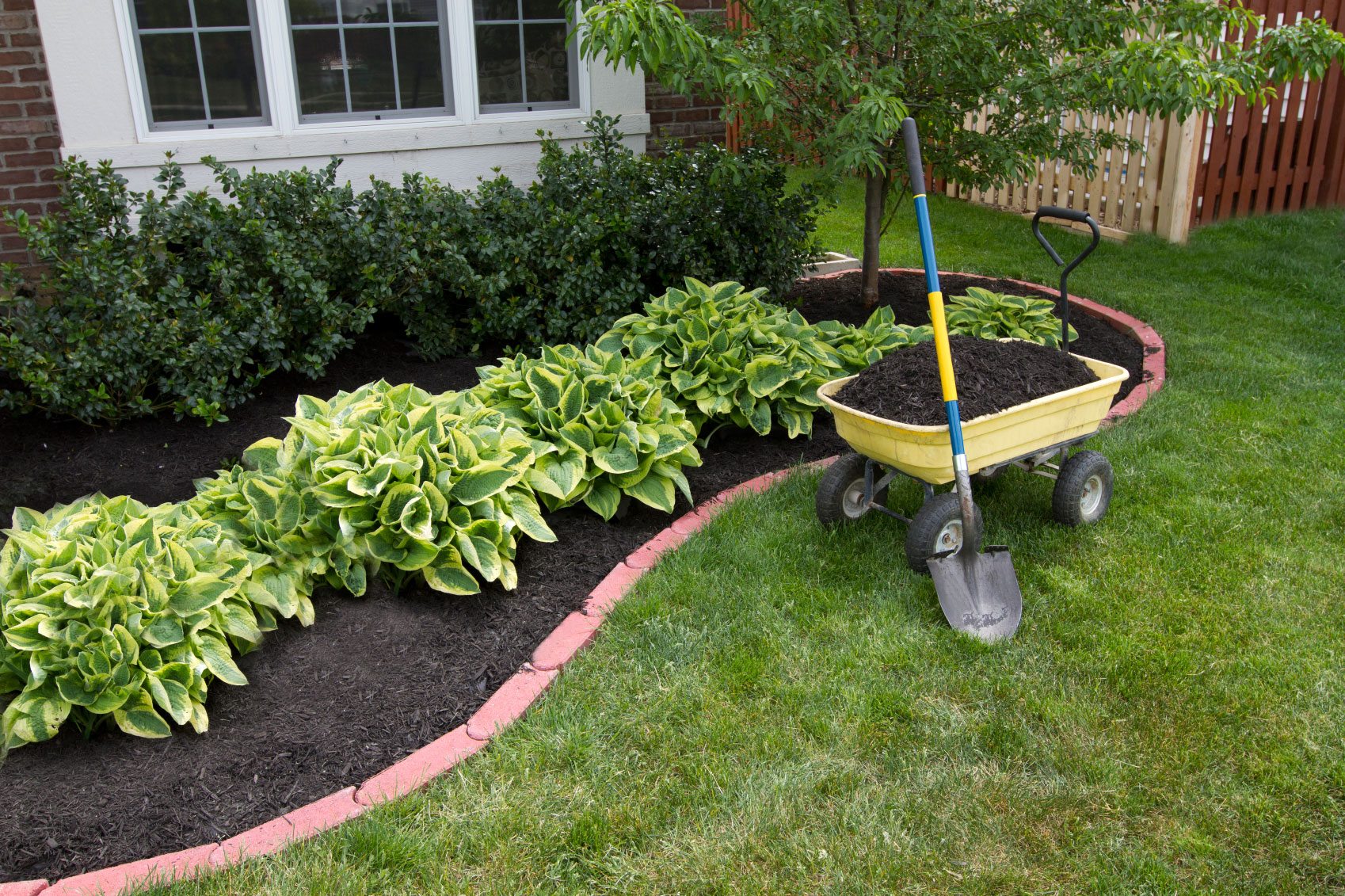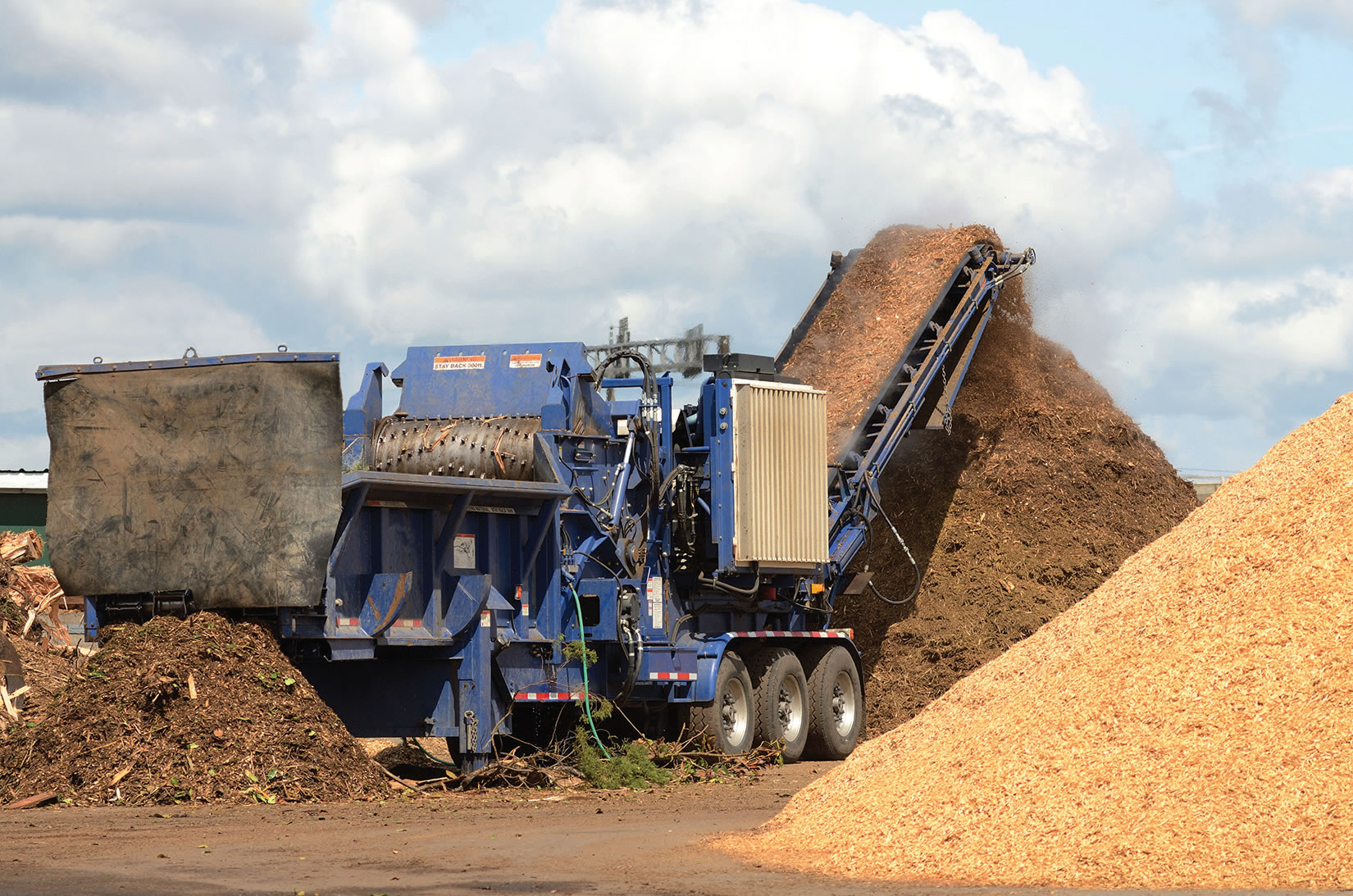By P.J. Heller
Zach Eaton remembers how long it used to take when loaders had to stack soil and mulch at the P.R. Russell facility in New Hampshire.
“If we got 20 trucks [with raw material] in a day, it would take all day and maybe some of the next day to stack it [the processed material] and get it up the hill with a loader,” he says.
No longer.
“Today, what they would bring in in a week, we would be able to put up in a day,” says Eaton, yard manager at Russell since 2007.
What brought about the boost in efficiency — along with several other benefits — was the addition of a radial stacking conveyor.
Stacking conveyors are used to stockpile material, such as soil, mulch, compost and aggregates, and can reduce or eliminate the need for wheel loaders. Conveyors can be fixed or tracked, allowing them to be easily moved around a facility. Models are available with varying feeder belt widths (i.e. 36 inch or 48 inch) and with various lengths or discharge heights, allowing for piles of different heights. Conveyors that rotate 180 degrees make it easy to place multiple piles next to each other.
While Eaton cites the productivity improvements with the radial stacking conveyor, he says the main emphasis for the purchase about eight years ago was due to skyrocketing fuel prices.
“When fuel prices were extremely high, we decided we needed to do something to the get material up the hill and not use so much fuel,” he explains. “We went from using 60 to 70 gallons a day on a loader to using 6 to 8 gallons a day on a stacking conveyor with a 4-cylinder diesel.
“There definitely is a huge savings,” he adds. “The machine definitely paid for itself within the first year.”
In addition to the fixed 125-foot radial stacking conveyor with its 48-inch-wide belt — which can create a mulch pile 52 feet high with 11,000 yards of material — P.R. Russell also operates a smaller 80-foot tracked conveyor with a 36-inch belt.
“When it comes down to really producing, we use the bigger stacker,” Eaton says, noting that with the company now in the throes of making product for the upcoming season, that larger conveyor “is definitely getting a workout.”
Russell, based in Brentwood, NH, serves the New England area, selling bagged and bulk mulch and playground chips as well as bagged soils and compost.
The company is contemplating adding a third stacking conveyor.
The conveyors allowed Russell to achieve other benefits, including labor savings, cutting maintenance costs on its wheel loaders and improved safety.
Other soil and mulch producers echo those benefits.
“Yes, all those benefits are there using stacking conveyors,” agrees Steve Jarahian, director of technical services at Oldcastle Lawn & Garden in Anderson, SC. “We installed [stacking conveyors] at several plants over the last 10 years to save loader time, space and money.”
“We have moved many plants over to conveying product especially when building stockpiles and feeding bag plants that are adjacent to the processing mills,” adds Jim McKay, manager of regional operations for Oldcastle APG in the Northeast.
“Depending on the conveyor length and setup, you can stack 50,000 yards before moving one yard of material,” Jarahian says.
Oldcastle has installed stacking conveyors at some of its more than 40 manufacturing plants located along the East Coast, the Gulf Coast of Florida and in the Midwest. The conveyors are a mix of rubber tire and tracked machines depending on terrain. They are used for stacking raw mulch, colored mulch, and screened pine bark fractions.
“Size, widths and lengths are all over the board,” Jarahian says of the conveyors.
McKay notes that conveyors used in the mulch industry are typically equipped with 36-inch-wide belts and range in length from 20 to 300 feet.
Oldcastle markets mulches, garden soils, potting mixes and soil amendments. Its retail brands include Jolly Gardener’ Just Natural Organics; Timberline; Green ‘n Grow, and Kolorscape. Oldcastle APG is also a manufacturer and supplier of concrete masonry, dry mix and hardscape products.
Larry Doose, president of Sylva Corp., in Princeton, MN, agrees that stacking conveyors are a boon to the industry.
Sylva, founded in 1997, is a manufacturer and wholesaler of bulk and bagged mulch, bagged soil and its SoftStep engineered wood fiber. It serves customers in Minnesota, North Dakota, South Dakota, Iowa and Wisconsin.
Doose reports a “substantial savings” using conveyors — the company has a total of six, including a tracked unit — versus wheel loaders.
“We don’t have to use the wheel loaders as much,” Doose says. “We used to have a dozer push piles up into the air. It would compress the pile and use a lot more energy. A conveyor uses a lot less energy to get material into a pile.”
The conveyors also provide a greater margin of safety, he says.
“It’s definitely safer, not having a machine up on a pile,” he explains. “There’s always a chance a machine could slide down or roll. So, we’ve reduced that exposure.”
Eaton agrees.
Once piles get high enough, loader operators driving up and down them can be in danger, he says.
“We still create roads on our piles just in case we have any type of fire. We need to be able to get to the top. So, when we’re stacking with the conveyor, we can build quite a big pile and then build a road up there with an excavator which is a lot safer than putting the loaders up on top,” he says.
Using stacking conveyers to build large piles also allows companies to better utilize their yard space, providing them with more usable space in their processing yard, says Samuel DeLullo, vice president of sales at Woodbed, Corp., a division of DeLullo Trucking.
A stacker can fit twice as much into a pile compared to other equipment, DeLullo says.
“We can utilize our property better,” agrees Doose of Sylva Corp. “It’s a nice efficient way of moving material and making piles.”
DeLullo says a typical loader may only be able to pile mulch or soil 14 feet to 16 feet high before having to drive on the pile, causing compaction. Conveyors on the other hand offer the benefit to make the finish piles much bigger, he notes.
“With the stackers we currently have we can pile material up to 37 feet without driving on top of the piles,” he says. “This is not something that is great to do with a raw product as you risk fire hazards if not done correctly.”
Woodbed operates two mobile stackers and a permanent custom-built radial stacker.
“These stackers really help when it comes to cutting cost on flipping piles as it costs less to run a loader and stacker compared to a dozer,” DeLullo says.
Woodbed, based in Saint Marys, PA, was started in 2005 and serves customers in Pennsylvania and New York. Products include mulch, wood chips, filter fiber and compost. DeLullo Trucking, started in 1990, brings in the raw materials to Woodbed, which turns them into finished products, then the trucking operation delivers those products to customers.
Numerous companies offer radial stacking conveyors that can be utilized by the soil, mulch and compost industry. Among them are Screen Machine Industries, headquartered in Etna, Ohio, Colorbiotics from BASF, and Peterson Pacific in Eugene, OR, a subsidiary of Astec Industries.
The Colorbiotics mulch conveyors all feature 36-inch belts and are available in lengths from 18 feet to 150 feet, with the most popular lengths being 50 and 60 feet. Depending on the length, they are equipped with either 10hp or 15hp motors.
While the Colorbiotics conveyors can handle a variety of materials, including aggregates, they are normally used in conjunction with the company’s Sahara and Second Harvester mulch coloring systems.
“The conveyors we sell can be used to handle any material, including aggregates, anywhere a conveyor is needed,” notes technical services manager David Roller, “but ours are specifically designed to incorporate and fit underneath and connect to our coloring systems.”
The conveyors can pivot 180 degrees to create multiple piles next to each other. At a standard angle of 25 degrees, 810 cubic yards of mulchcan fit under the 60-foot conveyor.
Peterson, in business since 1981, offers the TSR4280 tracked stacking conveyor, which it says can often eliminate the need for a wheel loader.
The conveyor is equipped with a 42-inch belt and its 80-foot conveyor length can stack materials up to 35 feet high. The conveyor, powered by a 58hp Kohler diesel engine, can pivot 180 degrees.
“Where the TSR4280 tracked radial stacking conveyor really excels is the ability to make 180-degree rows with over 11,000 cubic yard stockpiles in each row, a feature not found on many stacking conveyors,” the company says on its website.
Screen Machine, founded in 1966, offers six portable radial stackers, ranging in size from 30 to 80 feet, according to its website. Depending on the size of the conveyor, belt sizes range from 18 inches to 36 inches. Most models are available with either an electric, hydraulic or diesel power module; the company’s 60-foot portable track conveyor is powered by a self-contained 48hp Yanmar diesel engine, the company says.
“Portable stacking conveyors can fit any size operation. Being able to stockpile large amounts of material in high and wide piles without constantly repositioning your equipment is key to uninterrupted productivity,” the company says.
Related News
Subscribe Today
Every other month, Soil & Mulch Producer
News brings you important stories about:
• New Technology
• Products
• Industry News
• Research Studies
Soil & Mulch Producer News features articles and services relevant to your daily operations.











